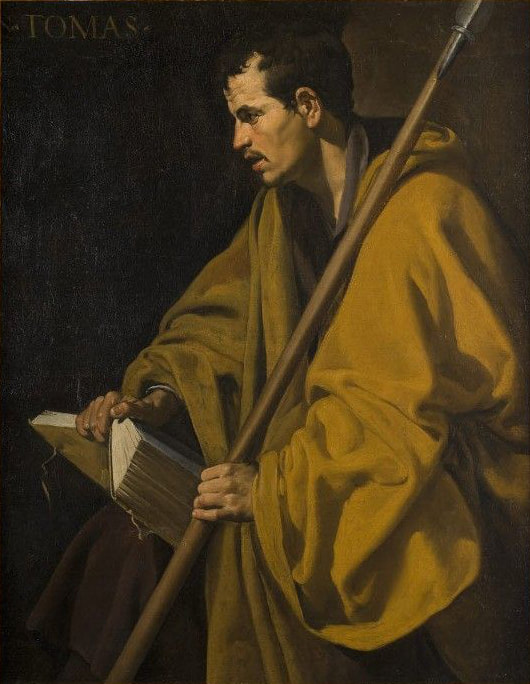|
Thomas, most commonly known as “Doubting Thomas” is one of the disciples with a speaking part in the Bible, and yet, he is barely mentioned in the Synoptic Gospels. Matthew 10:3, Mark 3:18 and Luke 6:15 list him as one of the twelve disciples but nothing is mentioned about how he became an apostle and what came after. For that, we have to turn to the Gospel of John.
Thomas is believed to have come from Galilee, however, he is listed as having two names. Thomas was his Aramaic name and Didymus was his Greek name, both of which mean “twin”. Although there is no explanation for the choice of names, it is most likely Thomas was born a twin. In the non-canonical Gospel of Thomas, the author gives his name as Judas Thomas. The first time Thomas’ name appears in John’s Gospel is John 11:16: “Then Thomas (also known as Didymus) said to the rest of the disciples, ‘Let us also go, that we may die with him.’” Jesus had learnt that his friend Lazarus was sick and had decided to visit him. The disciples were shocked by this decision because Lazarus lived in Judea where the Jewish population had tried to stone him. Yet, Jesus was adamant and Thomas encouraged the disciples to go with him. Thomas next speaks in John 14:5: “Thomas said to him, ‘Lord, we don’t know where you are going, so how can we know the way?’” Jesus had explained that he was going to prepare a place for them in heaven and that one day they would join him there. Thomas spoke on behalf of the disciples, explaining that they did not know where that place was or how to get there. Jesus responded to this with one of the most famous sayings in the bible: “I am the way and the truth and the life. No one comes to the Father except through me.” (14:6) Of course, the most famous exchange between Thomas and Jesus takes place after the resurrection. This is the scene that forever brands him as “Doubting Thomas.” “Now Thomas (also known as Didymus), one of the Twelve, was not with the disciples when Jesus came.” (John 20:24) To prove he had risen from the dead, Jesus visited the disciples in a locked room where they were hiding from the Jewish leaders, however, Thomas was not there. Unable to imagine someone coming back to life, Thomas doubted the disciples’ claim that they had seen the Lord. “Unless I see the nail marks in his hands and put my finger where the nails were, and put my hand into his side, I will not believe.” (20:25) The following week, Jesus visited the disciples again. This time, Thomas was with them and Jesus showed Thomas the nail marks and wound in his side. At once, Thomas believed, declaring “My Lord and my God!” (John 20:28) Unfortunately, it was too late for Thomas to redeem himself and he is still referred to as the doubter, giving his name to sceptics who refuse to believe without direct personal experience. “Jesus told him, ‘Because you have seen me, you have believed; blessed are those who have not seen and yet have believed.’” (20:29) Apart from these brief episodes in the Gospel of John, the Bible reveals nothing else about Thomas’ life. Scholars have turned to other literature to ascertain what happened to Thomas after Jesus was taken up into heaven. One belief is Thomas travelled to India in AD 52 to spread the Christian faith to the Jewish community that lived there at the time. Tradition claims he established seven churches while he was there and baptised many families. The theologian Origen of Alexandria (184-253) stated Thomas was the apostle to the Parthians, a historical region located in north-eastern Iran. Eusebius of Caesarea (c.260-340) recorded Thomas and Bartholomew were assigned to Parthia and India, and the Christian treatise Didascalia Apostolorum corroborates Thomas’ presence: "India and all countries considering it, even to the farthest seas... received the apostolic ordinances from Judas Thomas, who was a guide and ruler in the church which he built." Traditions of the Saint Thomas Church in India claim Thomas briefly visited China. In the Office of St. Thomas for the Second Nocturn written by Gaza of the Church of St. Thomas of Malabar, the following is claimed:
Saint Thomas has only been made patron of a handful of things, including India and Sri Lanka. Just for fun, here are a few fun “facts” about the apostle:
0 Comments
Your comment will be posted after it is approved.
Leave a Reply. |
©Copyright
We are happy for you to use any material found here, however, please acknowledge the source: www.gantshillurc.co.uk AuthorRev'd Martin Wheadon Archives
June 2024
Categories
All
|

 RSS Feed
RSS Feed